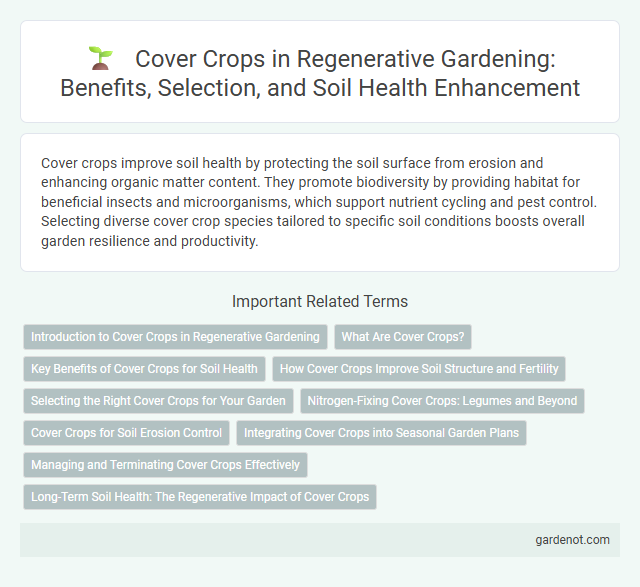Cover crops improve soil health by protecting the soil surface from erosion and enhancing organic matter content. They promote biodiversity by providing habitat for beneficial insects and microorganisms, which support nutrient cycling and pest control. Selecting diverse cover crop species tailored to specific soil conditions boosts overall garden resilience and productivity.
Introduction to Cover Crops in Regenerative Gardening
Cover crops play a crucial role in regenerative gardening by enhancing soil health, preventing erosion, and increasing biodiversity. These plants, such as clover, rye, and vetch, fix nitrogen, suppress weeds, and improve soil structure through root growth. Implementing cover crops promotes sustainable ecosystems and supports long-term agricultural productivity.
What Are Cover Crops?
Cover crops are plants grown primarily to protect and enrich soil between main crop cycles, enhancing soil structure, fertility, and biodiversity in regenerative gardens. They prevent erosion, suppress weeds, and improve moisture retention by increasing organic matter and microbial activity. Common cover crops include legumes, grasses, and brassicas, each contributing unique benefits like nitrogen fixation and pest resistance.
Key Benefits of Cover Crops for Soil Health
Cover crops significantly enhance soil health by preventing erosion, improving soil structure, and increasing organic matter content. They promote nutrient cycling by fixing nitrogen and suppressing weeds, which reduces the need for chemical fertilizers and herbicides. The root systems of cover crops improve soil aeration and water retention, fostering beneficial microbial activity essential for a resilient regenerative garden ecosystem.
How Cover Crops Improve Soil Structure and Fertility
Cover crops enhance soil structure by increasing organic matter and promoting healthy microbial activity, which boosts soil aggregation and porosity. Leguminous cover crops fix atmospheric nitrogen, enriching soil fertility and reducing the need for synthetic fertilizers. Their root systems prevent erosion, improve water retention, and create channels that facilitate root growth for subsequent crops.
Selecting the Right Cover Crops for Your Garden
Selecting the right cover crops for your regenerative garden enhances soil health by improving nutrient cycling and preventing erosion. Leguminous cover crops like clover and vetch fix atmospheric nitrogen, boosting soil fertility naturally. Incorporating grasses such as rye or oats promotes organic matter accumulation and suppresses weed growth effectively.
Nitrogen-Fixing Cover Crops: Legumes and Beyond
Nitrogen-fixing cover crops, primarily legumes such as clover, vetch, and peas, play a crucial role in regenerative gardening by naturally enriching soil nitrogen levels through symbiotic relationships with Rhizobium bacteria. Beyond legumes, plants like buckwheat and certain brassicas contribute to soil health by enhancing organic matter and supporting microbial diversity, although they do not fix nitrogen directly. Incorporating these diverse cover crops improves soil fertility, reduces the need for synthetic fertilizers, and promotes sustainable plant growth cycles.
Cover Crops for Soil Erosion Control
Cover crops such as clover, rye, and vetch play a crucial role in soil erosion control by providing a protective ground cover that reduces surface runoff and minimizes soil displacement. Their deep root systems improve soil structure and increase organic matter, enhancing water infiltration and retention. Implementing cover crops within regenerative gardening practices significantly stabilizes soil, prevents nutrient loss, and promotes long-term land health.
Integrating Cover Crops into Seasonal Garden Plans
Integrating cover crops into seasonal garden plans enhances soil fertility and structure by fixing nitrogen, increasing organic matter, and preventing erosion during off-peak gardening periods. Selecting species like clover, vetch, or rye complements crop rotation schedules, promoting biodiversity and pest suppression. Timely sowing and termination of cover crops optimize nutrient cycling and water retention, supporting sustainable regenerative garden practices.
Managing and Terminating Cover Crops Effectively
Effective management and termination of cover crops in regenerative gardens is essential to optimizing soil health and nutrient cycling. Techniques such as mowing, rolling, or using specific termination herbicides can control growth while minimizing soil disturbance and preserving microbial activity. Timing termination before seed set ensures maximum biomass incorporation, enhancing organic matter and suppressing weeds for the next planting cycle.
Long-Term Soil Health: The Regenerative Impact of Cover Crops
Cover crops enhance long-term soil health by increasing organic matter and promoting microbial diversity, which improves nutrient cycling and soil structure. Their deep root systems prevent erosion, enhance water retention, and sequester carbon, contributing to climate change mitigation. Consistent use of cover crops in regenerative gardening rejuvenates degraded soils, leading to sustained fertility and resilient ecosystems.
Cover crop Infographic

 gardenot.com
gardenot.com